German-born, British stage and screen actress Dolly Haas (1910-1994) was popular in the 1930s as a vivacious, red-haired gamine often wearing trousers in German and British films. Although she got a 3-year contract with Columbia and she worked with Alfred Hitchcock in Hollywood, Dolly's American career mainly took place on and Off-Broadway.

German collectors card in the Moderne Schönheitsgalerie by Ross Verlag for Kurmark cigarettes, no. 55. Photo: Hisa-Film.

German collectors card in the Moderne Schönheitsgalerie by Ross Verlag for Kurmark cigarettes. Photo: Dolly Haas in Warum lügt Fräulein Käthe?/Why is Miss Käthe lying? (Georg Jacoby, 1935).

German postcard by Ross Verlag, no. 6309/1, 1931-1932. Photo: Atelier Eli Marcus.

German postcard by Ross Verlag, no. 6565/1, 1931-1932. Photo: Atelier Schenker, Berlin.
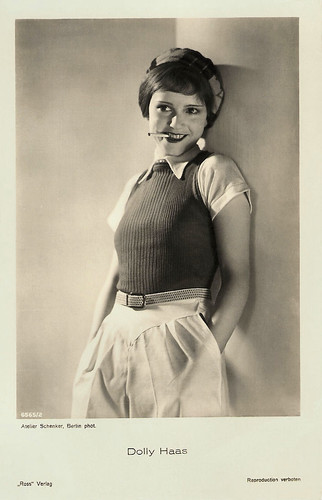
German postcard by Ross Verlag, no. 6565/2, 1931-1932. Photo: Atelier Schenker, Berlin.

German postcard by Ross Verlag, no. 8157/1, 1933-1934. Photo: Walther Jaeger, Berlin.
Dolly Haas was born Dorothy Clara Louise Haas (some sources write Hass) in 1910 in Hamburg, Germany. She was British: her grandfather was a Dane who lived in England and married an Englishwoman. Her father, Charles Oswald Haas, a bookseller and friend of Sir Henry Wood, had married the Austrian Margarete Maria née Hansen and settled in Hamburg.
At six, Dolly started with ballet lessons, and she had her first public dance performance in a production of 'Die Fledermaus' (The Bat). From 1917 until 1927, Dolly attended the progressive lyceum of Dr. Löwenberg.
After her graduation, she went to Berlin where Erik Charell gave her a large supporting role in his stage production of 'Mikado'. In 1930 the famous Max Reinhardt offered her an engagement in his stage production 'Wie werde ich reich und glücklich' (How Do I Become Rich and Happy) (1930, Erich Engel).
That same year she made her film debut as a department doll who comes to life in Eine Stunde Glück/One Summer of Happiness (Wilhelm (William) Dieterle, 1930). Her second film was Dolly macht Karriere/Dolly's Way to Stardom (1930), the directorial debut of Anatole Litvak.
Hal Erickson at AllMovie: "Dolly's Career top-bills the delightful Dolly Haas in the title role. It's a harmless little story about a starry-eyed chorus girl who hopes to become a big star and also keep her virtue, and of the various antagonists who try to prevent her from doing either. The film is highlighted by a number of elaborate dance sequences, gracefully performed by Haas and cleverly choreographed by Ernst Matray." The film title seemed prophetic for her future.

Dutch postcard by M. Bonnist & Zonen, Amsterdam, Z., no. B 168. Photo: Filma, Amsterdam. Publicity still for So ein Mädel vergisst man nicht/A Girl You Don't Forget (Fritz Kortner, 1932).
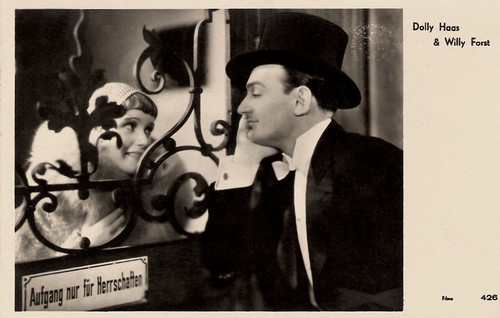
Dutch postcard by Filma, no. 426. Photo: publicity still for So ein Mädel vergisst man nicht/A Girl You Don't Forget (Fritz Kortner, 1932) with Haas and Willi Forst.

Dutch postcard by Filma, no. 430.


German collectors card in the Moderne Schönheitsgalerie by Ross Verlag for Kurmark cigarettes, no. 55. Photo: Hisa-Film.

German collectors card in the Moderne Schönheitsgalerie by Ross Verlag for Kurmark cigarettes. Photo: Dolly Haas in Warum lügt Fräulein Käthe?/Why is Miss Käthe lying? (Georg Jacoby, 1935).

German postcard by Ross Verlag, no. 6309/1, 1931-1932. Photo: Atelier Eli Marcus.

German postcard by Ross Verlag, no. 6565/1, 1931-1932. Photo: Atelier Schenker, Berlin.

German postcard by Ross Verlag, no. 6565/2, 1931-1932. Photo: Atelier Schenker, Berlin.

German postcard by Ross Verlag, no. 8157/1, 1933-1934. Photo: Walther Jaeger, Berlin.
A department doll who comes to life
Dolly Haas was born Dorothy Clara Louise Haas (some sources write Hass) in 1910 in Hamburg, Germany. She was British: her grandfather was a Dane who lived in England and married an Englishwoman. Her father, Charles Oswald Haas, a bookseller and friend of Sir Henry Wood, had married the Austrian Margarete Maria née Hansen and settled in Hamburg.
At six, Dolly started with ballet lessons, and she had her first public dance performance in a production of 'Die Fledermaus' (The Bat). From 1917 until 1927, Dolly attended the progressive lyceum of Dr. Löwenberg.
After her graduation, she went to Berlin where Erik Charell gave her a large supporting role in his stage production of 'Mikado'. In 1930 the famous Max Reinhardt offered her an engagement in his stage production 'Wie werde ich reich und glücklich' (How Do I Become Rich and Happy) (1930, Erich Engel).
That same year she made her film debut as a department doll who comes to life in Eine Stunde Glück/One Summer of Happiness (Wilhelm (William) Dieterle, 1930). Her second film was Dolly macht Karriere/Dolly's Way to Stardom (1930), the directorial debut of Anatole Litvak.
Hal Erickson at AllMovie: "Dolly's Career top-bills the delightful Dolly Haas in the title role. It's a harmless little story about a starry-eyed chorus girl who hopes to become a big star and also keep her virtue, and of the various antagonists who try to prevent her from doing either. The film is highlighted by a number of elaborate dance sequences, gracefully performed by Haas and cleverly choreographed by Ernst Matray." The film title seemed prophetic for her future.

Dutch postcard by M. Bonnist & Zonen, Amsterdam, Z., no. B 168. Photo: Filma, Amsterdam. Publicity still for So ein Mädel vergisst man nicht/A Girl You Don't Forget (Fritz Kortner, 1932).

Dutch postcard by Filma, no. 426. Photo: publicity still for So ein Mädel vergisst man nicht/A Girl You Don't Forget (Fritz Kortner, 1932) with Haas and Willi Forst.

Dutch postcard by Filma, no. 430.

Dutch postcard by Filma, no. 449. Photo: Dolly Haas, Willi Forst and Oskar Sima (left) in So ein Mädel vergisst man nicht/A Girl You Don't Forget (Fritz Kortner, 1932).

Dutch postcard by Filma, no. 514.
Delicate and Lovely Child-Woman
Dolly Haas continued her stage career as a dancer, singer, and streetwise girl. In her films, she often embodied a delicate and lovely child-woman who is superior to her male partners because of her wit and energy.
Popular comedies with her were Der brave Sünder/The Upright Sinner (Fritz Kortner, 1931) with Max Pallenberg and Heinz Rühmann, So ein Mädel vergisst man nicht/A Girl You Don't Forget (Fritz Kortner, 1932) with Willi Forst and Oskar Sima, and Scampolo, ein Kind der Straße/Scampolo (Hans Steinhoff, 1932) with Karl Ludwig Diehl.
She regularly acted in 'Hosenrolle’ (roles in trousers), such as in Liebeskommando/Love's Command (Géza von Bolváry, 1931) with Gustav Fröhlich. Dolly played a girl who masquerades as her brother in order to join the military academy.
Anti-semitic protests followed the premiere of Das hässliche Mädchen/The Ugly Girl (Hermann Kosterlitz, 1933). It came to riots against her Jewish co-star Max Hansen. The names of Jewish director Hermann Kosterlitz (later Henry Koster) and writer Felix Joachimson (later Felix Jackson) were taken off the credits.
IMDb: "This was the last film that Henry Koster directed in Berlin before having to leave due to Nazis. He left Berlin, having knocked out an SS officer, one day before filming was finished on the movie. The Nazis removed his name from the credits and substituted the name of Hasse Preiss, the lyricist."

German postcard by Ross Verlag, no. 6058/1, 1931-1932. Photo: Atelier Schrecker, Berlin.

German postcard by Ross Verlag, no. 6079/1, 1931-1932. Photo: Vandal & Delac. Dolly Haas, Reinhold Schünzel and Lucie Mannheim in Der Ball/The Ball (Wilhelm Thiele, 1931).

German postcard by Ross Verlag, no. 6423/1, 1931-1932. Photo: Ufa. Dolly Haas and Heinz Rühmann in Es wird schon wieder besser/Things Are Getting Better Already (Kurt Gerron, 1932).
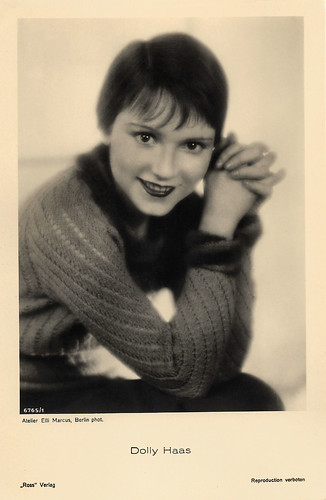
German postcard by Ross Verlag, no. 6765/1, 1931-1932. Photo: Atelier Elli Marcus, Berlin.

German postcard by Ross Verlag, no. 7186/1, 1932-1933. Photo: Lothar Stark-Film.

German postcard by Ross Verlag, no. 7397/1, 1931-1932. Photo: Walter Lichtenstein / Projectograph-Film. Publicity still for So ein Mädel vergisst man nicht/A Girl You Don't Forget (Fritz Kortner, 1932) with Haas and Willi Forst. Collection: Didier Hanson.
Girls Will Be Boys
After the National Socialists came to power in Germany, Dolly Haas and her first husband, the director Hans Brahm (later John Brahm), moved to England.
There, she again donned trousers for Girls Will Be Boys (Marcel Varnel, 1934). It involved her getting work at the all-male estate of a misogynistic duke (Cyril Maude). Only when she is saved from drowning while swimming in the nude, her gender is revealed.
She played in two more British films, including Broken Blossoms (John Brahm1936) a remake of the silent masterpiece. First, D.W. Griffith the director of the silent version had been hired.
The Guardian related in its 1994 obituary of Haas what happened: "while Dolly was contracted to play the Lillian Gish role of the Cockney waif, the director was rehearsing Ariane Borg, an unknown protegee of his. When the producers refused to use Borg, Griffith left to be replaced by Brahm. Delicately lovely, Haas, who researched the role by visiting Limehouse to watch slum children at play, was the saving grace of the film."
Her last British picture, before going to the US with her husband, was Spy Of Napoleon (Maurice Elvey, 1937), in which she was a dancer who believes herself to be Louis Napoleon's illegitimate daughter. In 1936 Haas signed a 3-year contract with Columbia and went to Hollywood, but after an 18-month wait for the right role, she left for New York.

German postcard by Ross Verlag, no. 7537/1, 1932-1933. Photo: Hisa-Film. Publicity still for Die Kleine Schwindlerin/The Little Crook (Johannes Meyer, 1933).

German postcard by Ross Verlag, no. 7538/1, 1932-1933. Photo: Hisa-Film. Publicity still for Die Kleine Schwindlerin/The Little Crook (Johannes Meyer, 1933) with Harald Paulsen.

Austrian postcard by Iris-Verlag, no. 6228. Photo: Kiba Verleih.

Austrian postcard by Iris Verlag, no. 6481. Photo: Hugo Ingel Film.

German postcard by Ross Verlag, no. 766. Photo: Atelier Yva, Berlin.
On and Off-Broadway
Dolly Haas became a naturalized U.S. citizen in 1940 and made her New York stage debut in Erwin Piscator's production of the Chinese fantasy 'The Circle of Chalk' (1941).
She had met famous caricaturist Al Hirschfeld when the artist was on assignment to draw a sketch of a summer theatre company for The New York Times. In 1942 they married and three years later their daughter Nina was born.
At that time Dolly had a successful career on and Off-Broadway and she appeared a.o. with John Gielgud and Lillian Gish in a stage adaptation of Fyodor Dostoyevsky's 'Crime and Punishment' (Theodore Komisarjevsky, 1947) at the National Theatre. She was also in the Off-Broadway productions of 'The Threepenny Opera' and 'Brecht on Brecht'.
Her only major movie role - after a 17-year absence on the screen - was in the high-profile I Confess (Alfred Hitchcock, 1953). She and O. E. Hasse played an artist couple whose emigration to the US ends in tragedy.
The Guardian: "she was superb as the doomed wife of the killer protected by priest Montgomery Clift's confessional vows." Thereafter she sporadically appeared on television.
In 1983, the Berlin International Film Festival dedicated a retrospective to her work. Her last screen appearance was in the documentary Dolly, Lotte und Maria/Dolly, Lotte and Maria (1987, Rosa von Praunheim) with Lotte Goslar, and Maria Ley Piscator.
Mel Gussow wrote about Haas and her husband in The New York Times: "For many decades the two were an elegant couple on the aisle at all Broadway opening nights, watching the actors and actresses whom Mr. Hirschfeld would sketch for The New York Times." They remained happily married until her death in 1994 at 84. Dolly Haas' ashes were scattered in the English Channel off Alderney, where her sister lived and died.
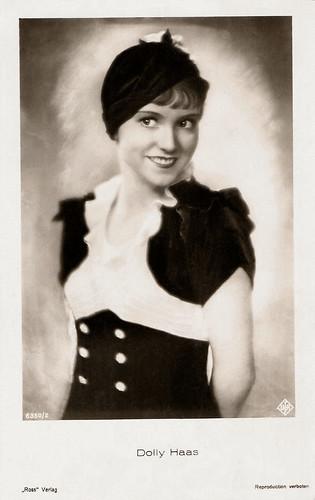
German postcard by Ross Verlag, no. 6350/2, 1931-1932. Photo: Ufa.

German postcard by Ross Verlag, no. 7825/1, 1932-1933. Photo: Willinger, Berlin. Dolly Haas in her outfit of Das hässliche Mädchen/The Ugly Girl (Henry Koster/Hermann Kosterlitz, Avanti-Tonfilm 1933), distributed by Bayerische Film.
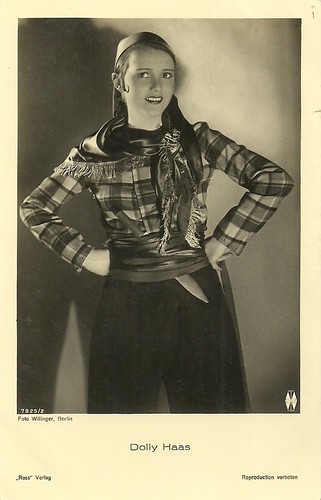
German postcard by Ross Verlag, no. 7825/2, 1932-1933. Photo: Willinger, Berlin. Dolly Haas in her outfit of Das hässliche Mädchen (Henry Koster/Hermann Kosterlitz, 1933).

German postcard by Ross Verlag, no. 8063/1, 1933-1934. Photo: Alex Binder, Berlin.

German postcard by Ross Verlag, no. 8324/1, 1933-1934. Photo: Lindner.
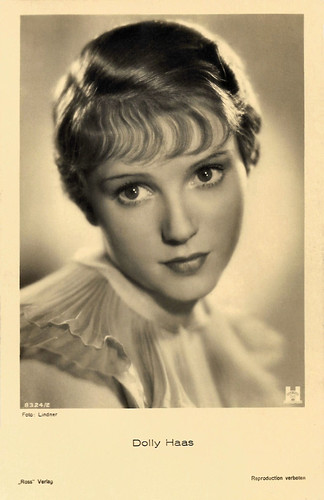
German postcard by Ross Verlag, no. 8324/2, 1933-1934. Photo: Lindner / Hisa-Film-Vertrieb GmbH. Dolly Haas in Es tut sich was um Mitternacht/So This Is Midnight (Robert A. Stemmle, 1934).
Sources: Mel Gussow (The New York Times), The Guardian, Hal Erickson (AllMovie), Thomas Staedeli (Cyranos), Filmportal.de, German Continental Strangers (Dartmouth.edu), Wikipedia, and IMDb.
This post was last updated on 9 December 2020.
3 comments:
Hello Bob,
Thank you for visiting my blog! I am so glad you stopped by~
WOW, you have quite a lovely collection of film star images! What a fabulous passion! Thank you for sharing with all of us bloggers.
Have a fabulous weekend, a joyous Easter, and continue to drink in the colors of Spring!
Dolly Hass recorded two titles for Polydor Paris in May 1932 :
5560 BKP N'aimer que toi
55611/2 BKP Nous sommes jeunes
Dolly Hass accompagnée par l'orchestre Wal-Berg
Polydor 522 333
Thank you for this information!
Post a Comment